Papers by Alejandro Hinojosa
Ecological Engineering, 2013
Ecological Engineering, 2013
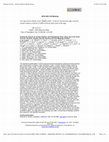
The significant earthquakes of 2010 produced surficial expressions ranging from blind faulting an... more The significant earthquakes of 2010 produced surficial expressions ranging from blind faulting and coastal uplift in Leogane, Haiti and Maule, Chile to surface faulting in Baja California, Mexico and Yushu, China. In Haiti and Baja California geodetic imaging methods strongly guided field reconnaissance and surface rupture mapping efforts, yet in quite different ways. In these challenging examples, InSAR, UAVSAR and optical image differencing, as well as SAR pixel tracking methods, were used to locate and quantify ground deformation and ruptures. In Baja California prominent rupture occurred in parts of the Cucapah mountains, yet along an 11 km-long stepover section, the zone of faulting was discontinuous and obscured by rockfalls. Optical image differencing helped identify surface rupture, especially through this stepover. SAR pixel tracking confirmed that rupture occurred along the newly identified Indiviso fault in Baja California, though masked by ground failure in the Colorado River Delta. Also in Baja California (and extending north of the US-MX border), a complex set of NE-SW cross-faults and N-S breaks were imaged with UAVSAR, InSAR, and aerial photography allowing the intricate pattern of faulting to be scrutinized. In Haiti, surface rupture along the inferred source fault was not observed during initial reconnaissance. This led to extensive imagery-and field-based searches for surface deformation, aided by InSAR, which revealed that surface deformation was caused primarily by off-fault blind thrusting. In Baja California, high resolution (up to 3-5 cm GSD) aerial imaging by low-altitude aerial stereo photography was then used to identify promising locations for measuring slip vectors on the fault, and to aid in mapping the surface rupture in detail (at 1:500 scale). Digital aerial photography with 0.1 m GSD by NOAA using their DSS 439 camera was rapidly reduced to orthomosaics (at 0.25 m GSD) and then used as uniform base imagery for rupture mapping. In Haiti, abundant high-resolution imagery including NOAA DSS orthomosaics and the RIT LiDAR data were rapidly available, and this aided in identification of potential paleoseismic sites that were later field-checked. Despite the wealth of imagery available, field investigation is essential because, 1) some of the most important features elude overhead imaging since they are small scale or obscured by vegetation, and 2) field study provides a spatially dense set of displacement data needed to characterize and compare surface ruptures associated with earthquakes of different magnitudes. International cooperation and collaboration, and sharing of imagery, resulted in rapid and successful responses. The new suite of rapidly and openly available imagery, and algorithms for exploiting such data, is becoming increasingly powerful, less expensive, and globally accessible.

Landscape and Urban Planning, 1999
Development threats to beautiful and productive agricultural areas occur throughout the world. Th... more Development threats to beautiful and productive agricultural areas occur throughout the world. This case study of one such productive valley reveals its agricultural uniqueness to Mexico and the pressures for its industrialization. Landscape and regional planning and environmental impact assessment tools were applied to suggest compatible and sustainable uses. Five environmental units were selected according to a digital model of the terrain and the overlapping of ecological maps, aerial photos and Landsat images. Descriptions included both natural and transformed physical attributes. Cultural and landscape architecture parameters were added to evaluate the aesthetics of each unit. Contrasting six potential land-uses (agriculture, agri-industry, tourism-recreation, urban, range management for cattle, and conservation) generated the capacity for sustained land-use, together with an environmental impact assessment. Economic means for directing land-use toward sustainability are to be developed by the local government. Community organization, local political pressure and the tastes of the national government will dictate its future use. #

ABSTRACT Aerial LiDAR surveys reconstruct with amazing fidelity the sinuosity of terrain relief. ... more ABSTRACT Aerial LiDAR surveys reconstruct with amazing fidelity the sinuosity of terrain relief. In this research we explore the 3D deformation field at the surface after a big earthquake (M7.2) by comparing pre- to post-event aerial LiDAR point clouds. The April 4 2010 earthquake produced a NW-SE surface rupture ~110km long with right-lateral normal slip up to 3m in magnitude over a very favorable target: scarcely vegetated and unaltered desert mountain range, sierras El Mayor and Cucapah, in northern Baja California, close to the US-México border. It is a plate boundary region between the Pacific and North American plates. The pre-event LiDAR with lower point density (0.013-0.033 pts m-2) required filtering and post-processing before comparing with the denser (9-18 pts m-2) more accurate post event dataset. The 3-dimensional surface displacement field was determined using an adaptation of the Iterative Closest Point (ICP) algorithm, implemented in the open source Point Cloud Library (PCL). The LiDAR datasets are first split into a grid of windows, and for each one, ICP iteratively converges on the rigid body transformation (comprising translations and rotations) that best aligns the pre- to post-event points. Testing on synthetic datasets perturbed with displacements of known magnitude showed that windows with dimensions of 100-200m gave the best results for datasets with these densities. The simplified surface rupture photo interpreted and mapped in the field, delineates very well the vertical displacements patterns unveiled by ICP. The method revealed block rotations, some with clockwise and others counter clockwise direction along the simplified surface rupture. As ground truth, displacements from ICP have similar values as those measured in the field along the main rupture by Fletcher and collaborators. The vertical component was better estimated than the horizontal having the latter problems in flat areas as expected. Hybrid approaches, as simple differencing, could be taken in these areas. Outliers were removed from results. ICP detected extraction from quarries developed between the two dates of LiDAR collection and expressed as a negative vertical displacement close to the sites. To improve the accuracy of the 3D displacement field, we intend to reprocess the pre-event source survey data to reduce the systematic error introduced by the sensor. Multidisciplinary approach will be needed to make tectonic inferences from the 3D displacement field revealed by ICP, about the processes at depth expressed at surface.
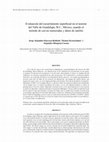
Revista Mexicana de Ciencias Geológicas
In order to recognize the soil and geomorphologic characteristics of the northeastern part of Val... more In order to recognize the soil and geomorphologic characteristics of the northeastern part of Valle de Guadalupe, Baja California, and its implications on the runoff volumes in the region, 59 soil samples were collected from the first 5 cm of the soil layer, taking into account the surface relief, soil classification and vegetation cover of each sampling point. Soil moisture content and textural analyses were carried out in the laboratory for each sample. Three raster images were used to complement field data: an Ikonos image, an Aster Image and the Instituto Nacional de Estadística Geografía e Informática digital geologic map I11D82. The Ikonos image was used to calculate the normalized differential vegetation index, the Aster image to evaluate the field slope, and the digital map to obtain geologic information for the study area. Following the runoff curve number method, a computational algorithm was developed (for Ermapper 6.4 software), by using the three raster images and the f...

Geophysical Journal International
A method is outlined by means of which it is possible to estimate high-resolution vertical displa... more A method is outlined by means of which it is possible to estimate high-resolution vertical displacements due to an earthquake even in the case where high-resolution topography is lacking before the earthquake. This result can be achieved by combining a highly accurate, post-event digital elevation model (DEM), for example lidar, with archived satellite imagery. The method is illustrated by calculating vertical displacements for the 2010 El Mayor-Cucapah earthquake. For this earthquake, there are both pre- and post-event lidar DEMs from which vertical displacements may also be estimated after correcting for the lateral advection of topography due to horizontal displacements. A comparison between the two means of deriving vertical displacements shows generally good agreement, with the displacements obtained using satellite imagery performing better in high relief areas. As a result of this property, we are able to trace the vertical offsets due to the El Mayor-Cucapah earthquake as th...

Deep sea explorations is a difficult endeavor, requiring to traverse a high pressure, dark and co... more Deep sea explorations is a difficult endeavor, requiring to traverse a high pressure, dark and cold environment. Detailed bathymetry collected with multibeam sonars onboard research vessels and on Autonomous Unmanned Vehicles (AUV), enable the planning of sea floor explorations using Remotely Operated Vehicles (ROV). During the exploration, the ROV collects , samples, physical parameters, video and photos, that can be associated to its 3D source position registered on the vehicles log. We present our experience of making a comprehensive synthesis of multiple hours of sea floor video and multimedia collected by an ROV during the exploration of the deep basins in Gulf of California and the transform faults that connect them. The 3D display of the ROV path and source position of multimedia over the detailed bathymetry helped the interpretation of the benthic communities and geomorphology by a multidisciplinary group.

We analyze a high-resolution (9 to 18 returns/m2) airborne LiDAR topographic survey of the 4 Apri... more We analyze a high-resolution (9 to 18 returns/m2) airborne LiDAR topographic survey of the 4 April 2010 M7.2 El Mayor-Cucapah surface rupture to quantify fault slip and the amount and style of distributed near-field deformation. This is the first LiDAR survey to capture a fresh rupture in a sparsely vegetated region with pre-earthquake lower-resolution (5m-pixel) LiDAR data. The amount of distributed deformation we observe suggests the frequency of large earthquakes on secondary fault arrays may often be underestimated from geologic observations of prehistoric fault slip.The earthquake produced a 120 km-long, complex multi-segment rupture with dextral-normal slip through northernmost Baja California, Mexico. The post-event survey reveals numerous surface ruptures, including subtle distributed slip above previously undocumented faults within the Colorado River delta. Differential elevations from comparison of pre- and post-event topography quantify distributed deformation surrounding...

We analyze the modification of fault scarps formed by the 4 April 2010 M 7.2 El Mayor-Cucapah ear... more We analyze the modification of fault scarps formed by the 4 April 2010 M 7.2 El Mayor-Cucapah earthquake through comparison of terrestrial LiDAR scans acquired within two weeks of the event to repeat scans one year later. From this comparison of annual scans we assess the mechanisms and rates of scarp modification in different substrates, and attempt to capture near-field post-seismic deformation. Constraining the manner and rate with which scarps degrade over time is necessary to understand the neotectonic record of past earthquakes, particularly in regions of diffuse faulting and infrequent ruptures. This earthquake provided an opportunity to scan freshly formed, nearly vertical scarps from which we can directly measure the initial rates and processes of scarp modification. We also seek evidence of afterslip and near-field subsidence that may have been caused by post-seismic relaxation of shallow stresses introduced by coseismic faulting. We conducted initial terrestrial LiDAR sur...

We assess the slip distribution at four sites along the 4 April 2010 El Mayor-Cucapah (EMC) earth... more We assess the slip distribution at four sites along the 4 April 2010 El Mayor-Cucapah (EMC) earthquake surface rupture in northern Baja-California with cm-resolution terrestrial lidar (TLS). Slip distributions based on field measurements typically show abrupt variation (0.5-2 m) over short along-strike distances (10 to 100 m), implying large along-fault strains (>10-2). While some of this variation may be real, the degree to which it can be attributed to measurement uncertainty is not well known because accurately assessing uncertainties in the field is difficult. We quantify this uncertainty by evaluating the repeatability of virtual field measurements using TLS datasets in an immersive 3D-cave environment. The TLS scans, collected 12 to 18 days following the EMC earthquake, capture fault displacements in a range of geologic and geomorphic settings. Where slip is concentrated on to a single fault plane, we build slip distributions by measuring individual displaced landforms, and...
Within the Baja California panhandle exist quite a significant number of valleys which hydrogeolo... more Within the Baja California panhandle exist quite a significant number of valleys which hydrogeology conditions are of great importance for the communities of the region. The Guadalupe Valley for example, located 30 km Northeast of Ensenada, hosts an important wine industry which presents a mayor factor for agriculture and tourism in Baja California. The irrigation is carried out basically by
Proceedings of the 11th Annual conference on Genetic and evolutionary computation - GECCO '09, 2009
... Stephen Bullock CICESE Km. 105 Tijuana-Ensenada Ensenada BC, México sbullock@cicese.mx Miguel... more ... Stephen Bullock CICESE Km. 105 Tijuana-Ensenada Ensenada BC, México sbullock@cicese.mx Miguel A. González Facultad de Ciencias Universidad Autónoma de Baja California Ensenada, BC, 22800 Alejandro Hinojosa CICESE Km. ...

ABSTRACT Aerial LiDAR surveys reconstruct with amazing fidelity the sinuosity of terrain relief. ... more ABSTRACT Aerial LiDAR surveys reconstruct with amazing fidelity the sinuosity of terrain relief. In this research we explore the 3D deformation field at the surface after a big earthquake (M7.2) by comparing pre- to post-event aerial LiDAR point clouds. The April 4 2010 earthquake produced a NW-SE surface rupture ~110km long with right-lateral normal slip up to 3m in magnitude over a very favorable target: scarcely vegetated and unaltered desert mountain range, sierras El Mayor and Cucapah, in northern Baja California, close to the US-México border. It is a plate boundary region between the Pacific and North American plates. The pre-event LiDAR with lower point density (0.013-0.033 pts m-2) required filtering and post-processing before comparing with the denser (9-18 pts m-2) more accurate post event dataset. The 3-dimensional surface displacement field was determined using an adaptation of the Iterative Closest Point (ICP) algorithm, implemented in the open source Point Cloud Library (PCL). The LiDAR datasets are first split into a grid of windows, and for each one, ICP iteratively converges on the rigid body transformation (comprising translations and rotations) that best aligns the pre- to post-event points. Testing on synthetic datasets perturbed with displacements of known magnitude showed that windows with dimensions of 100-200m gave the best results for datasets with these densities. The simplified surface rupture photo interpreted and mapped in the field, delineates very well the vertical displacements patterns unveiled by ICP. The method revealed block rotations, some with clockwise and others counter clockwise direction along the simplified surface rupture. As ground truth, displacements from ICP have similar values as those measured in the field along the main rupture by Fletcher and collaborators. The vertical component was better estimated than the horizontal having the latter problems in flat areas as expected. Hybrid approaches, as simple differencing, could be taken in these areas. Outliers were removed from results. ICP detected extraction from quarries developed between the two dates of LiDAR collection and expressed as a negative vertical displacement close to the sites. To improve the accuracy of the 3D displacement field, we intend to reprocess the pre-event source survey data to reduce the systematic error introduced by the sensor. Multidisciplinary approach will be needed to make tectonic inferences from the 3D displacement field revealed by ICP, about the processes at depth expressed at surface.
The 3D displacement field produced by the El Mayor-Cucapah earthquake (EMCE) was estimated using ... more The 3D displacement field produced by the El Mayor-Cucapah earthquake (EMCE) was estimated using the Iterative Closest Point (ICP) algorithm. Conceptually is a simple method, in an iterative process it aims to bring into alignment two corresponding sets of 3D points which model the same object.
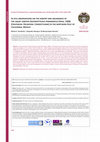
Journal of Threatened Taxa, 2013
Citation: Hendrickx, M.E., A. Hinojosa & M. Ayón-Parente (2013). In situ observations on the habi... more Citation: Hendrickx, M.E., A. Hinojosa & M. Ayón-Parente (2013). In situ observations on the habitat and abundance of the squat lobster Gastroptychus perarmatus (Haig, 1968) (Crustacea: Decapoda: Chirostylidae) in the northern Gulf of California, Mexico. Journal of Threatened Taxa 5(17): 5228-5236; http://dx.doi. org/10.11609/JoTT.o3133.5228-36 Copyright: © Hendrickx etal. 2013. Creative Commons Attribution 3.0 Unported License. JoTT allows unrestricted use of this article in any medium, reproduction and distribution by providing adequate credit to the authors and the source of publication. Funding: SEMARNAT-CONACYT (Project 107418 ), "Caracterización del fondo marino en las cuencas abisales y escarpes de fallas transformes en el golfo de California" Competing Interest: The authors declare no competing interests. Author Details and Contriction: Michel E. Hendrickx -Marine Biologist, PhD, expert in crustaceans and other invertebrates of the eastern Pacific. Head scientist of the TALUD project. Interpretation and identification of the biological material on the video used in this contribution. Senior redactor of the contribution. Alejandro Hinojosa -Marine Geologist, MSc, expert in Mexican Pacific geology and marine oceanography. Participant in the JASON cruise and head of the CICESE project dealing with the video footage taken by the JASON. Manuel Ayon-Parente -Marine Biologist, PhD, expert in decapod crustaceans. Member of the TALUD cruises staff. Revision and edition of photographs used in this contribution. A. Duarte, Abril Pérez, Yesenia González, Cristina Quezada, Pamela Flores, Fernanda Pares and Pablo Echevarria for their dedicated and persistent effort exploring the many hours of the ROV submarine videos and systematically registering observations. We also thank Stephen Cairns, Smithsonian Institution, for providing some clues related to the identification of Callogorgia.
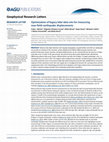
Geophysical Research Letters, 2014
Airborne lidar (light detection and ranging) topography, acquired before and after an earthquake,... more Airborne lidar (light detection and ranging) topography, acquired before and after an earthquake, can provide an estimate of the coseismic surface displacement field by differencing the preevent and postevent lidar point clouds. However, estimated displacements can be contaminated by the presence of large systematic errors in either of the point clouds. We present three-dimensional displacements obtained by differencing airborne lidar point clouds collected before and after the El Mayor-Cucapah earthquake, a M w 7.2 earthquake that occurred in 2010. The original surface displacement estimates contained large, periodic artifacts caused by systematic errors in the preevent lidar data. Reprocessing the preevent data, detailed herein, removed a majority of these systematic errors that were largely due to misalignment between the scanning mirror and the outgoing laser beam. The methodology presented can be applied to other legacy airborne laser scanning data sets in order to improve change estimates from temporally spaced lidar acquisitions. (2014), Optimization of legacy lidar data sets for measuring near-field earthquake displacements, Geophys. Res. Lett., 41,


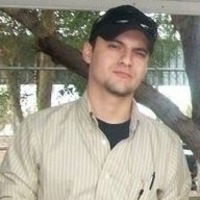

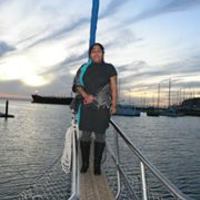

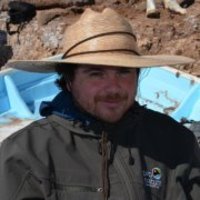
Uploads
Papers by Alejandro Hinojosa